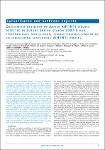Oseltamivir-resistant influenza A(H1N1) viruses detected in Europe during season 2007-8 had epidemiologic and clinical characteristics similar to co-circulating susceptible A(H1N1) viruses
Ciancio, B. C.
Meerhoff, T. J.
Kramarz, P.
Bonmarin, I.
Borgen, K.
Boucher, C. A.
Buchholz, Udo
Buda, Silke
Dijkstra, F.
Dudman, S.
Duwe, Susanne
Hauge, S. H.
Hungnes, Olav
Meijer, Adam
Mossong, J.
Paget, W. J.
Phin, N.
Sande, M. van der
Schweiger, Brunhilde
Nicoll, A.
During the 2007-08 influenza season, high levels of oseltamivir resistance were detected among influenza A(H1N1) viruses in a number of European countries. We used surveillance data to describe influenza A(H1N1) cases for whom antiviral resistance testing was performed. We pooled data from national studies to identify possible risk factors for infection with a resistant virus and to ascertain whether such infections led to influenza illness of different severity. Information on demographic and clinical variables was obtained from patients or their physicians. Odds ratios for infection with an oseltamivir resistant virus and relative risks for developing certain clinical outcomes were computed and adjusted through multivariable analysis. Overall, 727 (24.3%) of 2,992 tested influenza A(H1N1) viruses from 22 of 30 European countries were oseltamivir-resistant. Levels of resistance ranged from 1% in Italy to 67% in Norway. Five countries provided detailed case-based data on 373 oseltamivir resistant and 796 susceptible cases. By multivariable analysis, none of the analysed factors was significantly associated with an increased risk of infection with an oseltamivir-resistant virus. Similarly, infection with an oseltamivir-resistant virus was not significantly associated with a different risk of pneumonia, hospitalisation or any clinical complication. The large-scale emergence of oseltamivir-resistant viruses in Europe calls for a review of guidelines for influenza treatment.
No license information

